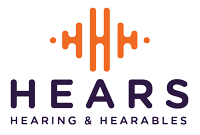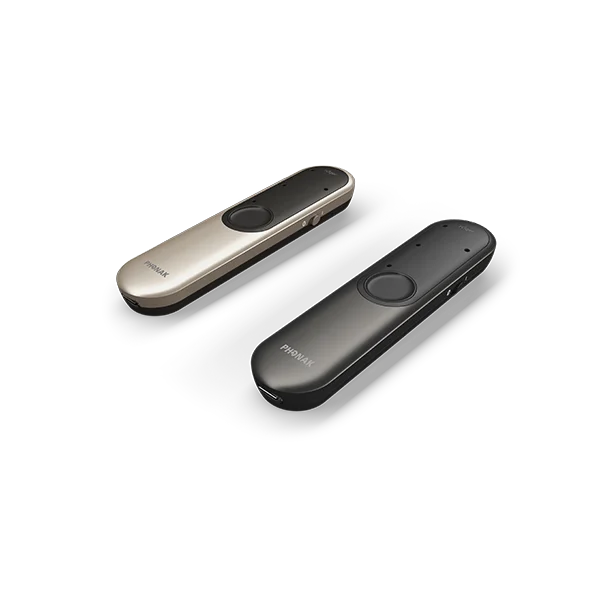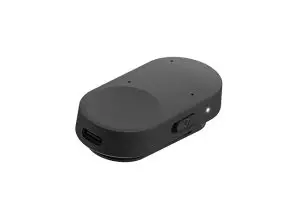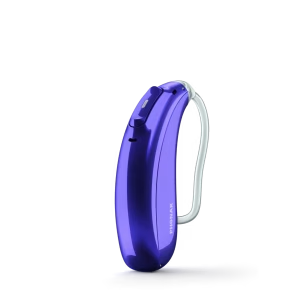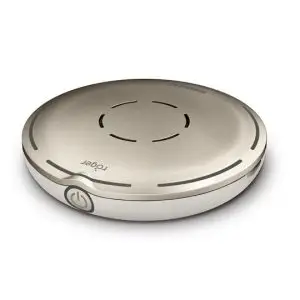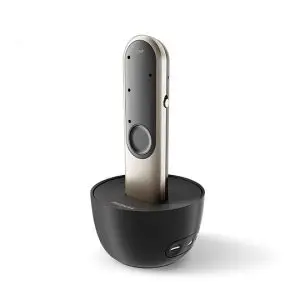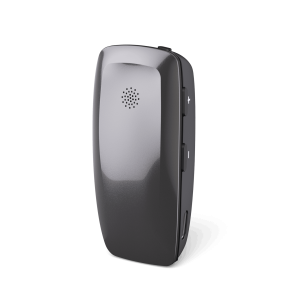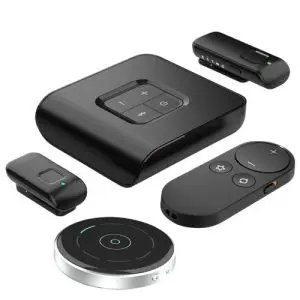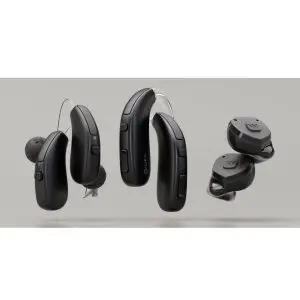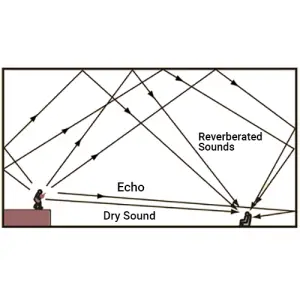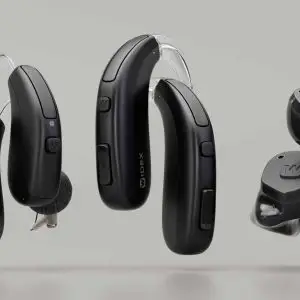Hearing Better with Remote Microphones: A Practical Guide
For individuals with hearing loss, one of the biggest challenges is understanding speech in noisy environments or from a distance. That’s where remote microphones and FM systems come in. These tools can significantly improve the listening experience of hearing in noise, but only if they’re used correctly. Let’s explore how these systems work, their differences, and how to get the most out of them.
Remote Microphones vs FM Systems: What’s the Difference?
Though both aim to improve the signal-to-noise ratio (SNR), making speech clearer by reducing background noise, they do so in slightly different ways: Below is a little explanation to keep it clear and simple.
FM Systems:
- Use radio frequencies to transmit sound from a microphone worn by a speaker to the listener’s hearing aids. FM means Frequency Modulation, like a radio wave transmission.
- Known for strong performance, especially in educational settings, where the distance between teacher and student matters.
- Typically require receivers on the hearing aids and a transmitter (mic) with the speaker.
- Still popular, but less common among modern hearing aid brands, phonak remains one of the few that still supports a robust FM lineup.
Remote Microphones:
- Use Bluetooth or proprietary wireless protocols to stream audio directly from the microphone to hearing aids.
- Easier to set up and more user-friendly.
- Often more versatile and compact, blending in with daily life better.
- Commonly supported by most modern hearing aid manufacturers.
Why Proximity to the Speaker Matters to Improve Hearing in Noise
Both FM and remote microphones excel when placed close to the speaker’s mouth—ideally within 6 to 12 inches. The closer the mic is to the source, the better the clarity and reduction in background noise.
Imagine trying to understand someone talking from across a noisy room. Now imagine that same person speaking directly into a microphone you’re listening to through your hearing aids—it’s night and day. That’s the power of these systems.
Phonak’s Remote Microphone Solutions
Phonak offers several advanced options, especially through its Roger™ line. These systems stand out for their adaptive technology and ease of use:
Roger Select:
- Designed for group settings.
- Uses multiple directional microphones that automatically focus on the person speaking.
- Can be placed on a table and will pick up voices from different directions.
- Excellent for meetings, restaurants, or family gatherings.
Roger On:
- The most advanced in the lineup.
- Features Motion Sensors that adapt mic behavior based on placement (e.g., table, hand-held, clipped).
- Includes a pointing mode for focusing directly on a talker even from a distance.
- Range: up to 25 meters (82 feet) with line of sight.
Other Pen-Style Remote Mics Worth Noting
While Phonak dominates this category, other manufacturers also offer pen-like or clip-on microphones:
ReSound Multi Mic:
- Offers up to 25 meters of range.
- Can be used as a tabletop mic, clipped onto clothing, or even with loop systems.
- Streams directly to ReSound hearing aids or cochlear implants.
Oticon ConnectClip and EduMic:
- Doubles as a remote mic and hands-free headset.
- Shorter range (around 10 meters), but useful for 1:1 conversations.
- Great for phone calls and media streaming.
Best Practices for Users
To ensure the best performance from your remote microphone:
- Position the mic close to the speaker’s mouth, clipping it on their shirt is ideal.
- In group settings, place it centrally on the table (for mics like Roger Select).
- Avoid placing it near noisy objects (like fans or clattering dishes).
- Make sure it’s charged and properly paired with your hearing aids.
- When possible, point the mic at the speaker (Roger Pen/Roger On) for better focus.
Research indicates that FM (Frequency Modulation) systems generally provide superior speech perception in noisy environments compared to standard directional microphones in hearing aids.
Key Findings:
- Enhanced Speech Perception: A study by Lewis et al. (2004) compared directional microphones and FM systems, finding that FM systems significantly improved speech perception in noise for individuals with sensorineural hearing loss.
- Improved Signal-to-Noise Ratio (SNR): FM systems can enhance the SNR by 10 to 20 dB over unaided listening conditions, outperforming the 3 to 8 dB improvement typically achieved with directional microphones
- Consistent Performance Across Environments: FM systems maintain their effectiveness in various settings, including classrooms and noisy public spaces, by transmitting the speaker’s voice directly to the listener’s hearing aid, reducing the impact of background noise and distance.
What about Hearing Loops? How Do They Differ From FM Systems
A hearing loop system (also known as an induction loop) transmits sound directly to hearing aids equipped with a telecoil (T-coil). It works by creating a magnetic field within a designated area, such as a room, a counter, or a section of seating, using a physical wire loop installed around that space. When a person activates the T-coil in their hearing aids, they can “tune in” to that magnetic signal, receiving clear, direct audio from a microphone connected to the loop system. This method is wireless, seamless, and doesn’t require the user to wear or carry extra devices.
How to Find and Use a Hearing Loop
Hearing loops are a powerful ALD to meet ADA law for clearer hearing in large public venues like theaters, churches, airports, and auditoriums. To locate a loop-equipped space near you, visit ALDlocator.org, a free, easy-to-use directory of accessible venues across the U.S.
To use a hearing loop, your hearing aids must be equipped with telecoils (T-coils), tiny coils inside the hearing aid that can pick up electromagnetic signals directly from the loop system. When you enter a looped area (look for the blue ear-and-“T” symbol), simply switch your hearing aids to the “T” or “MT” setting to start hearing sound from the venue’s microphone system right in your ears.
Important: Not all hearing aids come with T-coils. When purchasing new hearing aids, be sure to ask if they include a telecoil. If they don’t, consider choosing a model that does, especially if you often attend events or visit public places. The hearing loop experience can make a world of difference, offering incredibly clear, focused sound even in large, noisy venues where hearing is typically most difficult. There are a lot of hearing loops in Wisconsin, New York, and even Washington DC.
While hearing loops are highly valued for public accessibility, especially in theaters, churches, and auditoriums, they rely on the infrastructure being properly installed and maintained. FM systems, on the other hand, are more portable, customizable, and adaptable to individual users and various environments, like classrooms or one-on-one conversations.
While both hearing loops (induction loops) and FM systems are effective assistive listening technologies, research comparing their audio fidelity is limited. Some studies, however, suggest that FM systems may still offer superior signal-to-noise ratio (SNR) and speech clarity in certain environments.
The Main Difference:
- Hearing Loops: Hearing loops provide consistent audio quality within their coverage area and are beneficial in settings like theaters and places of worship. However, their performance can be affected by electromagnetic interference and the quality of the t-coil in the hearing aid. FM systems are better for personal use.
Final Thoughts on Improving Hearing in Noise
Remote microphones are an incredible tool for enhancing speech understanding, especially in noise and at a distance. While FM systems still have their place, modern Bluetooth and wireless remote mics offer greater flexibility, more affordable, and ease of use.
If you’re using a Phonak hearing aid, exploring the Roger system, especially Roger On or Roger Select, can open up a world of sound that was once difficult to access. For other brands, check with your provider to find a compatible remote mic that fits your lifestyle.
Ready to hear better in the noisiest situations? Start by bringing the mic closer.
